


A rack railway (also known as a rack and pinion railway or cog railway) is a steep grade railway with a toothed rack rail, usually between the running rails. The trains are fitted with one or more cog wheels or pinions that mesh with this rack rail. This allows trains to operate on steep grades above 7 to 10 percent, which is the maximum for an adhesion based railway. Most rack railways are mountain railways, although a few are transit railways or tramways built to overcome a steep gradient in an urban environment.
The first mountain cog railway was the Mount Washington Cog Railway in the American state of New Hampshire. The first mountain rack railway in continental Europe was the Vitznau Rigi Bahn on Mount Rigi in Switzerland. Both lines are still operational today.
Today the vast majority of rack railways use the Abt system but a number of different rack systems have been developed including the following:

The first successful rack railway in America was the Mount Washington Cog Railway, developed by Sylvester Marsh. Marsh was issued a U.S. patent for the general idea of a rack railway in September 1861, and in January 1867 for a practical rack where the gear teeth take the form of rollers arranged like the rungs of a ladder between two L-shaped wrought iron rails. The first public trial of the Marsh rack on Mount Washington was made on 29 Aug 1866, when only one quarter of a mile (402 meters) of track had been completed. The Mount Washington railway opened to the public on 14 Aug 1868. Construction reached the summit 1869. The pinion wheels on the locomotives have deep teeth that ensure that at least two teeth are engaged with the rack at all times, this measure helps reduce the possibility of the pinions riding up and out of the rack.
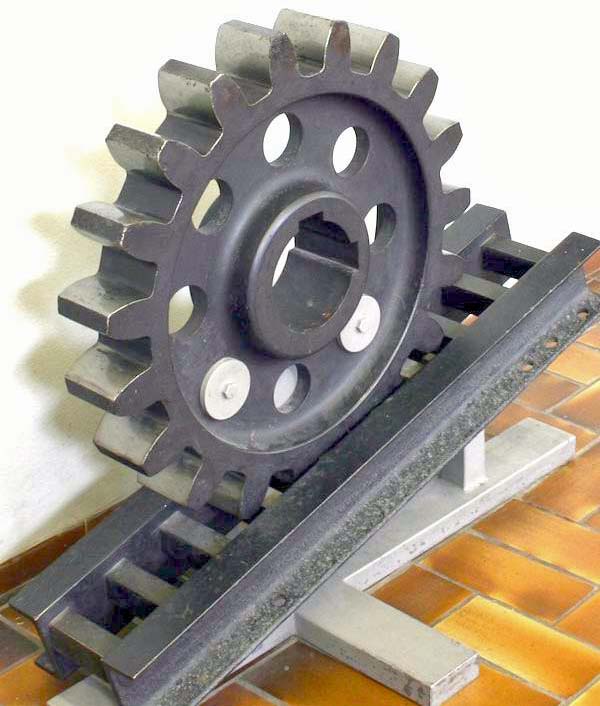
The Riggenbach rack system was invented by Niklaus Riggenbach working at about the same time as, but independently from Marsh in America. Riggenbach was granted a French patent in 1863 based on a working model which he used to interest potential Swiss backers. During this time, the Swiss Consul to the United States visited Marsh's Mount Washington Cog Railway and reported back with enthusiasm to the Swiss government. Eager to boost tourism in Switzerland, the government commissioned Riggenbach to build a rack railway up Rigi Mountain. Following the construction of a prototype locomotive and test track in a quarry near Bern, the Vitznau Rigi Bahn opened on 22 May 1871. The Riggenbach system is similar in design to the Marsh system. It uses a ladder rack, formed of steel plates or channels connected by round or square rods at regular intervals. The Riggenbach system suffers from the problem that its fixed ladder rack is more complex and expensive to build than other systems.
opened on 22 May 1871. The Riggenbach system is similar in design to the Marsh system. It uses a ladder rack, formed of steel plates or channels connected by round or square rods at regular intervals. The Riggenbach system suffers from the problem that its fixed ladder rack is more complex and expensive to build than other systems.

In 1900, E.C. Morgan of Chicago received a patent on a rack railway system that was mechanically similar to the Riggenbach rack, but this rack was also used as a third rail to power an electric locomotive. Morgan went on to develop heavier locomotives and turnouts for this system with J.H. Morgan. In 1904, he patented a simplified but compatible rack, where the teeth on the engine pinions engaged square holes punched in a bar-shaped center rail. J.H. Morgan patented several alternative turnout designs for use with this rack system. Curiously, Morgan recommended an off-center rack in order to allow clear passage for pedestrians and animals walking along the tracks. Some photos of early Morgan installations show this. A simplified rack mounting system could be used when the Morgan rack was not used for third-rail power and the Morgan rack offered interesting possibilities for street railways. The Morgan rack was good for grades of up to 16 percent.
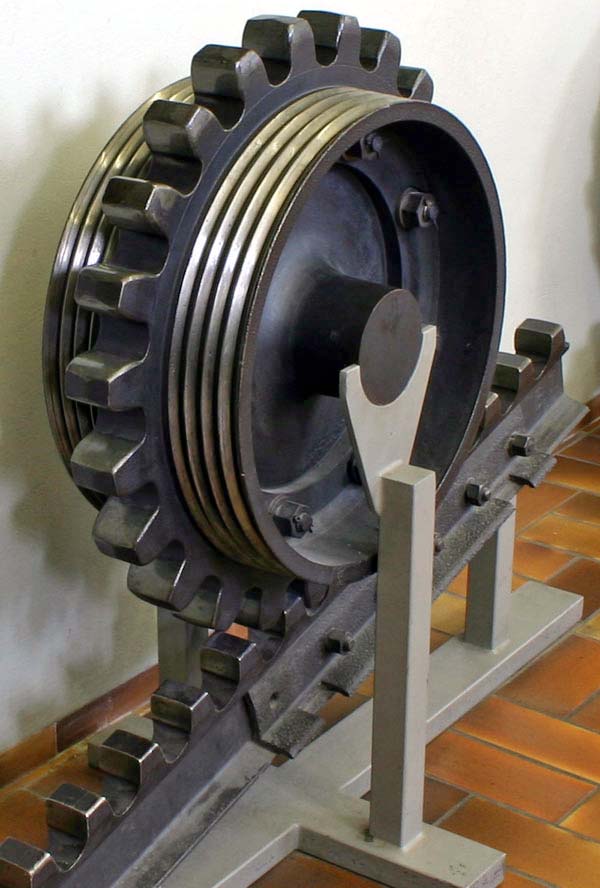
The Strub rack system was invented by Emil Strub in 1896. It uses a rolled flat-bottom rail with rack teeth machined into the head approximately 100 millimetres apart. Safety jaws fitted to the locomotive engage with the underside of the head to prevent derailments and serve as a brake. Strub's US Patent, granted in 1898, also includes details of how the rack rail is integrated with the mechanism of a turnout. The best known use of the Strub system is on the Jungfraubahn in Switzerland. It is the simplest rack system to maintain and has become increasingly popular.
in Switzerland. It is the simplest rack system to maintain and has become increasingly popular.
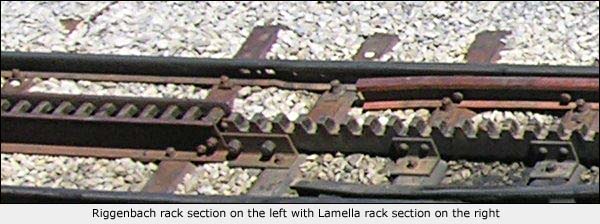
The Lamella system (also known as the Von Roll system) was developed by the Von Roll company after the rolled steel rails used in the Strub system became unavailable. It is formed from a single blade cut in a similar fashion to the Abt system but typically wider than a single Abt bar. The Lamella rack can be used by locomotives designed for use on the Riggenbach or the Strub systems, so long as the safety-jaws that were a feature of the original Strub system are not used. Some railways use rack from multiple systems, for example, the St. Gallen Gais Appenzell Railway in Switzerland has sections of Riggenbach, Strub, and Lamella rack.
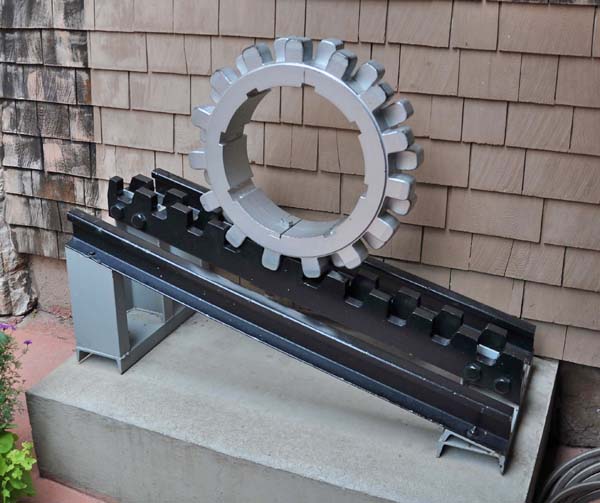
The Abt system was devised by Roman Abt, a Swiss locomotive engineer. Abt worked for Riggenbach at his works in Olten and later at his IGB rack locomotive company. In 1885, he founded his own civil engineering company. During the early 1880s, Abt worked to devise an improved rack system that overcame the limitations of the Riggenbach system. In particular, the Riggenbach rack was expensive to manufacture and maintain and the switches were complex. In 1882, Abt designed a new rack using solid bars with vertical teeth machined into them. Two or three of these bars are mounted centrally between the rails, with the teeth offset. The use of multiple bars with offset teeth ensures that the pinions on the locomotive driving wheels are constantly engaged with the rack. The Abt system is cheaper to build than the Riggenbach because it requires a lower weight of rack over a given length. However the Riggenbach system exhibits greater wear resistance than the Abt.
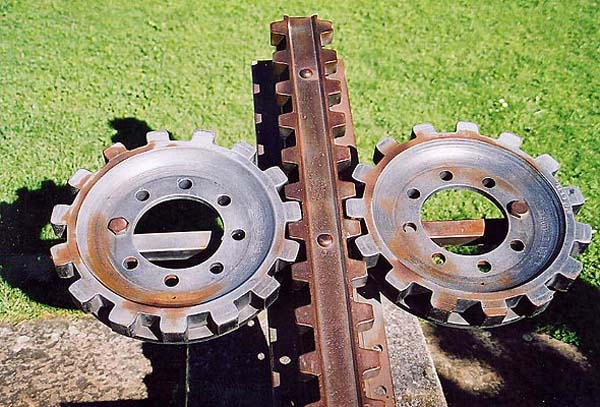
The Locher rack system, invented by Eduard Locher, has gear teeth cut in the sides rather than the top of the rack, engaged by two cog wheels on the locomotive. This system allows use on steeper grades than the other systems, whose teeth could jump out of the rack. It is used on the Pilatus Bahn which has a maximum gradient of 48 percent. Locher set out to design a rack system that could be used on gradients as steep as 50 percent. The Abt system, the most common rack system in Switzerland at the time, was limited to a maximum gradient of 25 percent. Locher showed that on steeper grades, the Abt system was prone to the driving pinion over-riding the rack, causing potentially catastrophic derailments, as predicted by Dr. Abt. To overcome this problem and allow a rack railway up the steep sides of Mount Pilatus, Locher developed a rack system where the rack is a flat bar with symmetrical, horizontal teeth. Horizontal pinions engage the centrally mounted rack, both driving the locomotive and keeping it centered on the track. A lip beneath the pinions teeth prevent disengagement from the rack. This system provides very stable attachment to the track, and also protects the car from toppling over even under the most severe crosswinds. Such gears are also capable of leading the car, so even flanges on running wheels are optional. The biggest shortcoming of the system is that a standard railway switch is not usable. A transfer table or other complex device must be used where branching of the track is needed. Following tests, the Locher system was deployed on the Pilatus Bahn, which opened in 1889. No other public railway uses the Locher system, although some European coal mines use a similar system on steeply graded underground lines.
Source Wikipedia